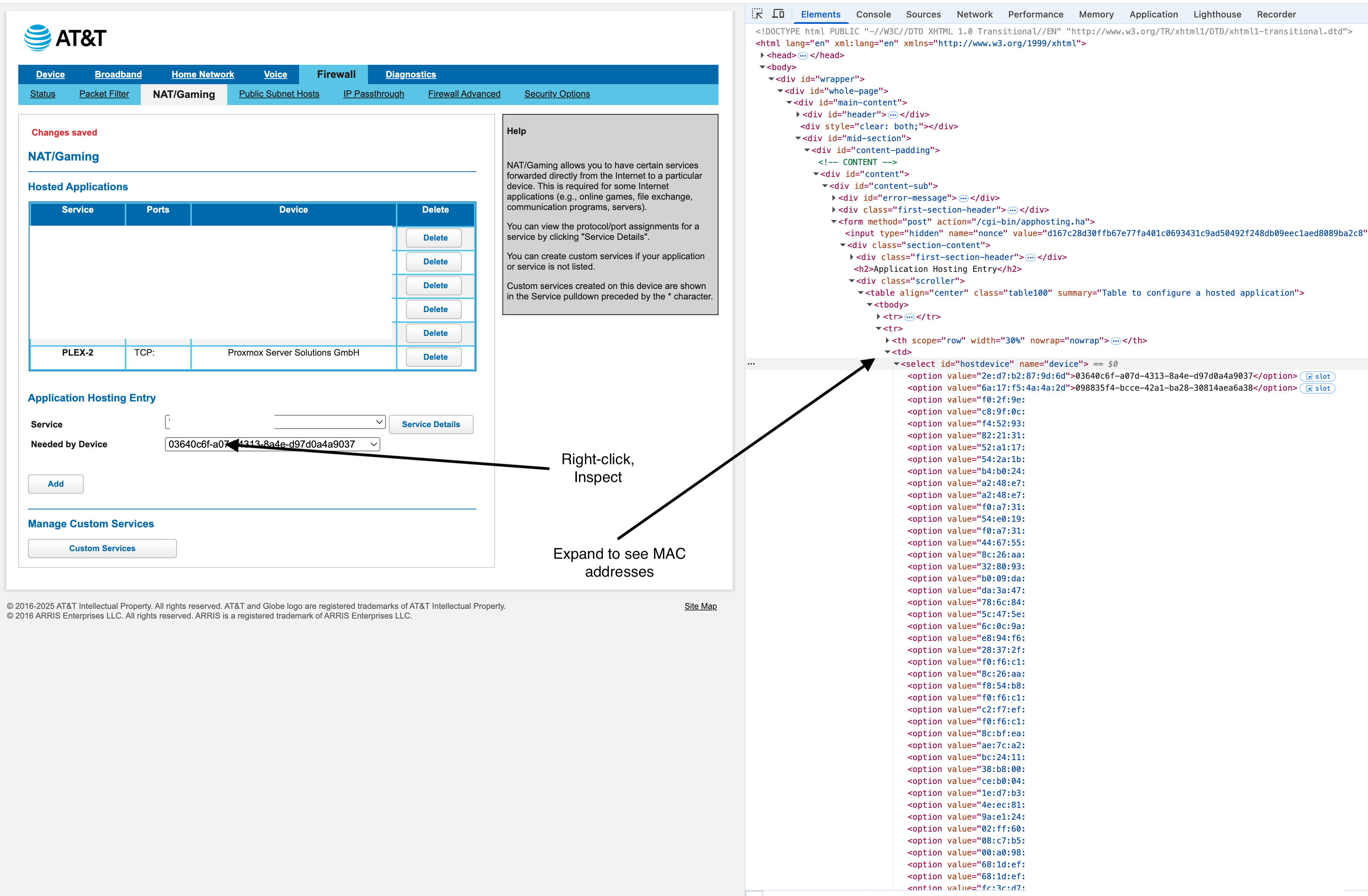Problem Description

AT&T/Nokia home routers have a frustrating limitation when configuring NAT/Gaming rules: instead of showing clear device hostnames or IP addresses, they display cryptic device names that make it impossible to identify which device you want to configure.
This creates a significant usability issue when:
- Setting up port forwarding rules
- Configuring DMZ settings
- Creating custom NAT rules
- Managing multiple devices with similar names
The Issue in Detail
What You See in the Interface:
- Dropdown shows generic names like “Device 1”, “Device 2”
- Or manufacturer codes like “036402ff-c07e-4942-b4d4-d97d3c4a0037”
- No correlation to actual device hostnames
- No IP address information visible
- Multiple devices may appear with identical names
What You Need:
- Clear device identification
- Correlation between router entry and actual network device
- Way to distinguish between similar devices (e.g., multiple phones, computers)
The Workaround Solution
The solution involves using browser developer tools to inspect the HTML dropdown and extract MAC addresses, which can then be matched to your actual devices.
Step-by-Step Process:
1. Access Router Configuration
1. Navigate to your router's web interface (typically 192.168.1.254)
2. Go to Firewall → NAT/Gaming
3. Navigate to the section where you need to select a device
4. DO NOT select anything in the dropdown yet
2. Open Browser Developer Tools
Chrome/Edge:
- Press
F12orCtrl+Shift+I(Windows/Linux) - Press
F12orCmd+Option+I(Mac)
Firefox:
- Press
F12orCtrl+Shift+I(Windows/Linux) - Press
F12orCmd+Option+I(Mac)
Safari:
- Enable Developer menu: Safari → Preferences → Advanced → “Show Develop menu”
- Press
Cmd+Option+I
3. Inspect the Device Dropdown
1. In Developer Tools, click the "Elements" or "Inspector" tab
2. Click the element selector tool (cursor icon)
3. Click on the device dropdown in the router interface
4. The HTML will highlight the <select> element
5. Look for <option> elements within the dropdown
4. Extract MAC Addresses from HTML
In the developer console, you’ll see HTML similar to this:
<select id="devicelist" name="device">
<option value="d0:17:c2:d3:f0:d7-4313-4efe-d970d-44a703">Device Name 1</option>
<option value="bc:24:11:7d:1b:59-3820-3f0f-4ea3-832fab33a">Proxmox Server Solutions GmbH</option>
<option value="f4:12:fa:ab:cd:ef-4455-6677-8899-aabbccddeeff">Unknown Device</option>
</select>
Key Information:
- The
valueattribute contains the MAC address - Format:
MAC-ADDRESS-ADDITIONAL-IDENTIFIER - The first part (before the dash) is the actual MAC address
5. Match MAC Addresses to Devices
Create a reference table of your network devices:
| Device | MAC Address | How to Find |
|---|---|---|
| Windows PC | ipconfig /all | Look for “Physical Address” |
| Mac | ifconfig or System Preferences → Network | Look for “Hardware” or “Ethernet ID” |
| Linux | ip link show or ifconfig | Look for “ether” or “HWaddr” |
| iPhone/iPad | Settings → General → About | “Wi-Fi Address” |
| Android | Settings → About Phone → Status | “Wi-Fi MAC address” |
| Router/Switch | Device label or web interface | Usually printed on device |
6. Find Your Device
Example from screenshot:
<option value="bc:24:11:7d:1b:59-xxxx-xxxx-xxxx-xxxxxxxxxxxx">Proxmox Server Solutions GmbH</option>
- MAC Address:
BC:24:11:7D:1B:59 - Matches: Our Plex container from earlier (Container MAC: BC:24:11:7D:1B:59)
- Device: Proxmox server running Plex
Router-Specific Workarounds
AT&T BGW210, BGW320, NVG599
These models commonly show this issue. Additional tips:
# Check connected devices via router CLI (if available)
curl -u "admin:password" "http://192.168.1.254/cgi-bin/devices.cgi"
# Alternative: Check DHCP lease table
# Navigate to: Home Network → Wi-Fi → Advanced Options → DHCP Lease Table
Nokia/Alcatel-Lucent Models
<!-- Look for these HTML patterns -->
<select name="deviceId">
<option value="mac-address-uuid">Device Name</option>
</select>
<!-- Or -->
<option data-mac="aa:bb:cc:dd:ee:ff" value="device-id">Name</option>
Prevention & Long-term Solutions
1. Document Device MACs During Setup
- Record MAC addresses when adding new devices
- Keep a network inventory spreadsheet
- Use network scanning tools regularly
2. Use Network Discovery Tools
# Scan local network (install nmap)
nmap -sn 192.168.1.0/24
# Show ARP table (shows MAC addresses)
arp -a
# Use advanced network scanner
sudo nmap -sS -O 192.168.1.0/24
3. Router Alternatives
- Consider upgrading to prosumer equipment (UniFi, pfSense)
- Use third-party firmware if supported
- Implement proper network management tools
Troubleshooting Tips
If MAC Addresses Don’t Match:
- Device has multiple interfaces: Check Wi-Fi vs Ethernet MAC
- MAC randomization: iOS/Android may use random MACs
- Bridge/NAT: Device behind another router/switch
- VLAN configuration: Device on different network segment
If HTML Structure Is Different:
// Generic finder for any select element
document.querySelectorAll('select option').forEach(opt => {
console.log(`Text: ${opt.textContent} | Value: ${opt.value}`);
});
// Look for MAC patterns in all page content
const pageHTML = document.documentElement.outerHTML;
const macRegex = /([0-9A-Fa-f]{2}[:-]){5}([0-9A-Fa-f]{2})/g;
const macs = pageHTML.match(macRegex);
console.log('Found MAC addresses:', macs);
Security Considerations
Why This Workaround Is Necessary:
- Router manufacturers prioritize simplicity over functionality
- Generic device names prevent user confusion
- But create bigger problems for advanced configuration
Privacy Implications:
- MAC addresses are unique identifiers
- Can be used to track devices across networks
- Modern devices use MAC randomization for privacy
Best Practices:
- Keep device inventory private and secure
- Regularly update router firmware
- Use strong router admin passwords
- Consider network segmentation for sensitive devices
Conclusion
While AT&T/Nokia routers’ device naming is frustrating, the browser developer tools workaround provides a reliable method to identify devices by their MAC addresses. This technique works across different router models and firmware versions.
Related Resources
- AT&T Router Documentation
- MAC Address Lookup Tools
- Network Discovery with Nmap
- UniFi Alternative Solution
Last updated: August 9, 2025
Tested on: AT&T BGW320-505 with Nokia firmware